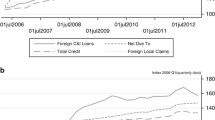Abstract
This paper is motivated by the ongoing debate about the Basel III impact on the efficient functioning of the banking sector. We empirically examine the effect that the implementation of the net stable funding ratio has on real economy. Using data from the EU banking sector, we conduct a retrospective analysis by simulating and investigating historically the NSFR index and its role in the implementation of a common monetary policy. We intervene on the traditional bank lending channel of Bernanke and Blinder (Am Econ Rev 82:901–921, 1992) by incorporating the interaction term between liquidity and interest rates. The analysis is conducted both at an aggregated loan supply level and by loan category while it incorporates, additionally to the interaction term, conventional asset pricing approaches with the adoption of self-financing trading strategies detecting nonlinearities in the relationship between liquidity provisions and bank lending channel. According to our findings, there is evidence of a heterogeneous response of financial intermediaries’ loan supply (due to changes of interest rates) across different NSFR levels. Banks with higher NSFR respond positively to an interest rate increase, by restructuring their loans’ portfolios to achieve higher risk-adjusted returns, conditional on the presence of an efficient asset allocation. On the contrary, low NSFR banks reduce loan supply as a response to higher interest rates.
Similar content being viewed by others
References
Angelini, P., et al. 2011. Basel III: Long-term impact on economic performance and fluctuations. BIS Working Papers, No 338.
Bank of International Settlements. 2012. Basel III regulator consistency assessment (Level 2) Preliminary report: European Union, October 2012.
Bank of International Settlements. 2013. Basel III: The liquidity coverage ratio and liquidity risk monitoring tools, January 2013.
Bank of International Settlements. 2014. “Consultative Document”, Basel III: The net stable funding ratio, April 2014
Bernanke, B., and A. Blinder. 1992. The federal fund rate and the channels of monetary transmission. American Economic Review 82: 901–921.
Blundell, R., and S. Bond. 1998. Initial conditions and moment restrictions in dynamic panel data models. Journal of Econometrics 87: 115–143.
Boot, A.W., and A.V. Thakor. 1993. Self-interested bank regulation. The American Economic Review 83: 206–212.
Chen, L., et al. 2017. The Basel III net stable funding ratio adjustment speed and systemic risk. Research in International Business and Finance 39: 169–182.
Chen, X. 2007. Banking deregulation and credit risk: Evidence from the EU. Journal of Financial Stability 2: 356–390.
Chiaramonte, L., and B. Casu. 2017. Capital and liquidity ratios and financial distress. Evidence from the European Banking Industry 49: 138–161.
DeYoung, R., and K.Y. Jang. 2016. Do banks actively manage their liquidity? Journal of Banking & Finance 66: 143–161.
Dietrich, A., et al. 2014. The good and bad news about the new liquidity rules of Basel III in Western European countries. Journal of Banking & Finance 44: 13–25.
Freixas, X., and A.M. Santomero. 2003. An overall perspective on banking regulation. UPF, Economics and Business Working Paper, No. 664.
Funk, R.J., and D. Hirschman. 2014. Derivatives and deregulation, financial innovation and the demise of Glass–Steagall. Administrative Science Quarterly 59: 669–704.
Gobat, J., et al. 2014. The net stable funding ratio: Impact and issues for consideration. International Monetary Fund Working Paper, WP/14/106.
Härle, P., et al. 2010. Basel III and European banking: Its impact, how banks might respond, and the challenges of implementation. EMEA Banking, 16–17.
Hong, H., et al. 2014. The information content of Basel III liquidity risk measures. Journal of Financial Stability 15: 91–111.
Jobst, A. 2014. Measuring systemic risk-adjusted liquidity (SRL)—A model approach. Journal of Banking & Finance 45: 270–287.
Joskow, P.L., and R.G. Noll. 1981. Regulation in theory and practice: An overview. In Studies in public regulation, ed. G. Fromm. Cambridge: The MIT Press.
Kalish, L., III., and R.A. Gilbert. 1973. The influence of bank regulation on the operating efficiency of commercial banks. The Journal of Finance 28: 1287–1301.
Khan, M.S., et al. 2016. Funding liquidity and bank risk taking. Journal of Banking & Finance 82: 203–216.
Kim, D., and W. Sohn. 2017. The effect of bank capital on lending: Does liquidity matter? Journal of Banking & Finance 77: 95–107.
King, M.R. 2013. The Basel III net stable funding ratio and bank net interest margins. Journal of Banking & Finance 37: 4144–4156.
Parker, D. 1999. Regulation of privatised public utilities in the UK: Performance and governance. International Journal of public sector management 12: 213–236.
Peek, Joe, and Eric Posengren. 1995. Bank regulation and the credit crunch. Journal of Banking and Finance 19: 679–692.
Perotti, E., and J. Suarez. 2011. A Pigovian approach to liquidity regulation. De Nederlandsche Bank Working Paper No. 291.
Santomero, A.M. 1984. Modeling the banking firm: A survey. Journal of Money, Credit and Banking 16: 576–602.
Uche, C.U. 2001. The theory of regulation: A review article. Journal of Financial Regulation and Compliance 9: 67–80.
Wei, X., et al. 2017. The impacts of net stable funding ratio requirement on Banks’ choices of debt maturity. Journal of Banking & Finance 82: 229–243.
Yan, M., et al. 2012. A cost–benefit analysis of Basel III: Some evidence from the UK. International Review of Financial Analysis 25: 73–82.
Author information
Authors and Affiliations
Corresponding author
Ethics declarations
Conflict of interest
On behalf of all authors, the corresponding author states that there is no conflict of interest.
Additional information
Publisher's Note
Springer Nature remains neutral with regard to jurisdictional claims in published maps and institutional affiliations.
Appendix
Appendix
See Figs. 1, 2, 3, 4 and Tables 1, 2, 3, 4, 5, 6, 7, 8, 9, 10.
Rights and permissions
About this article
Cite this article
Papadamou, S., Sogiakas, D., Sogiakas, V. et al. The role of net stable funding ratio on the bank lending channel: evidence from European Union. J Bank Regul 22, 287–307 (2021). https://doi.org/10.1057/s41261-021-00144-6
Accepted:
Published:
Issue Date:
DOI: https://doi.org/10.1057/s41261-021-00144-6








